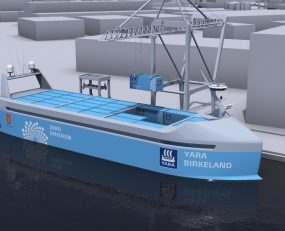
Autonomous technology has seen varying degrees of success in air and overland transport. In the logistics industry, driverless trucks and drones usually make the headlines, but the applications for this technology extend further.
As such, two Norwegian companies are now developing what they claim would be the first fully electric and autonomous container ship.
The task is being undertaken by Yara International ASA, an agricultural and chemicals company and Kongsberg, a high-tech systems manufacturer for the merchant marine, defence, aerospace and offshore oil and gas sectors.
Their project, the Yara Birkeland, is a $25m undertaking, which is scheduled for deployment in late 2018. It will transport fertilizer 37 miles in Norwegian waters from Yara’s production port in Larvik to Brevik. The ship will have a capacity of around 100-150 TEU and will be fully run on a 3.5-4MWh set of batteries. In its original stages, the operation will be manned but by 2020 it will be fully autonomous.
The initial cost is high as it incorporates the costs of GPS, lidar, infra-red and high resolution cameras needed to operate this new type of vessel. However, its operating costs are likely to be dramatically lower than a normal container ship. Reports suggest annual operating costs could fall by up to 90%, with no fuel costs or seafarers to pay for.
There are a variety of other developments within the sector too. Kongsberg in fact are in a separate undertaking with UK-based Automated Ships Ltd and French offshore services company Bourbon Offshore, in which they are developing an autonomous prototype vessel for servicing the offshore energy, hydrographic & scientific and offshore fish-farming industries. Rolls Royce Holdings meanwhile is leading a project called the Advanced Autonomous Waterborne Applications (AAWA) initiative which works with other companies and universities to developing new solutions in the area. One Baltic operator involved in AAWA, Finferries, is utilising a variety of sensors and thermal cameras, alongside its manned operations in its Stella Ferry. These are said to be improving safety, by increasing awareness of the environment and making it easier for crews to navigate.
The success of such projects thus far has shown the strength of the concept. Petter Ostbo, Yara’s head of production, told the Wall Street Journal that the company hopes to invest in larger autonomous ships for even longer routes and “maybe even move our fertilizer from Holland all the way to Brazil” when international regulations for crewless vessels are set.
Just last month the International Maritime Organisation announced it would launch a study into amending laws to permit the use of unmanned vessels. However, it is likely to be some time before any full regulations are set.
So as with autonomous cars, it will likely be regulation that holds back the deployment of fully autonomous ships. However, the accompanying technology used already has a part to play in aiding maritime transport by cutting fuel costs, increasing safety and helping navigation. In the short term, these developments will compliment manned operations on vessels, though in the long term they may replace them altogether.
If you are interested in finding out more about technology in logistics, see Trends in Logistics Technology, an exclusive Ti report on the critical technological developments and solutions that will shape the future of the logistics industry.
Source: Transport Intelligence, July 25, 2017
Author: Andy Ralls